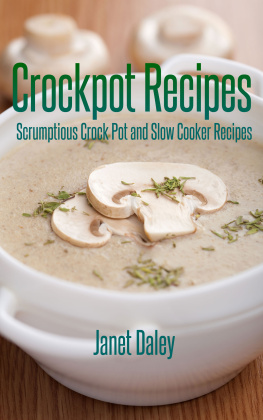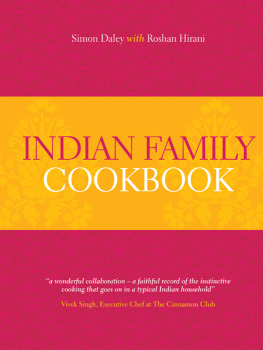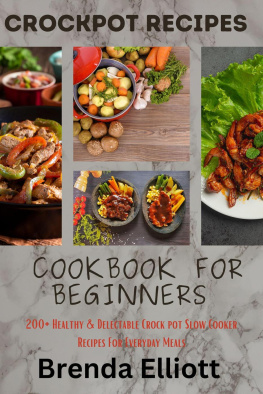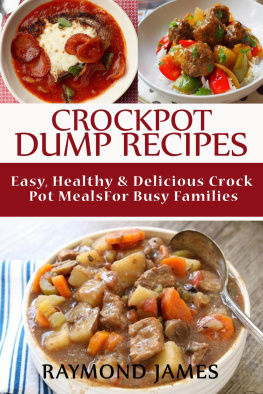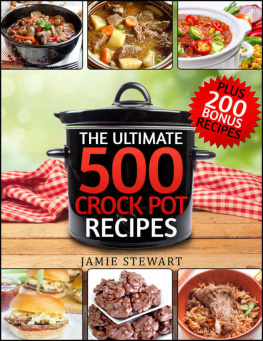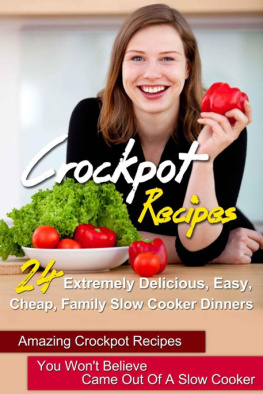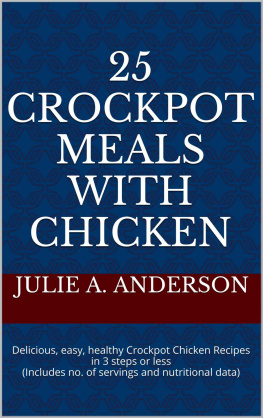Table of Contents
Crockpot Recipes Scrumptious Crock Pot and Slow Cooker Recipes Janet Daley Copyright 2013 Janet Daley All rights reserved.
Introduction
Enter the new era of slow cooking and find the answers to healthy, convenient and flavor-rich foods. Steeped in their own juices and contained in a temperature regulated environment, contents are allowed to keep many of their vitamins, normally lost through boiling and baking methods. As society wakes up and sees the negative effects that greasy and fast foods have on the human body, crock pots are making a huge comeback. If you are one of the thousands that are looking to improve your health, keep meals simple, and enjoy the succulent flavor of foods, this book is just for you. Learn how almost any type of meal can be created by using your crock pot.
Not limited to meats and stews, you will discover how fruits and vegetables can retain a rich and fascinating flavor. Green beans, carrots and peppers will keep their natural juices and nutrients, then wrap their wonderful flavor around other added foods. By using spices and herbs, see how new and exciting creations can rejuvenate classic dishes. Create new foods from scratch, like yogurt and applesauce, or make movie night a special occasion with cinnamon almonds, that are warm and atomic. Learn how to prepare fresh vegetables, or entire meals, for storage, once the growing season is over. There are also many treats that are shown in this book that you never dreamed could be made with a slow cooker.
The rich flavors that are held within your crock pot, and slow cooked to perfection, will convince you that crock pots are here to stay. When crock pots were first introduced in the early 1970s, their purpose was one of time saving meal preparation. By placing a chicken or roast in the slow cooker in the morning, you could find a tender, tasty main meal, hours later. Unfortunately, the crock pot was forced to compete with the emerging microwave oven and drive-through restaurants. What seemed an easier and more grandiose way of eating, the crock pot was quietly stored on a shelf. It is time to pull out that amazing piece of cookware and learn how to make your life easier, healthier and create better tasting meals.
To get back into the swing of things, a 5-day meal planner has been included, along with tips for purchasing a crockpot. While your old model may work just fine, discover the updates and additional features that have been added over the past 40 years. Read about the benefits of slow cooking and how those with little practice in cooking, can create gourmet foods. While the microwave is still a handy tool in everyday living, you will find that your crock pot has an important place on your kitchen counter.
Chapter 1: Benefits of Crockpot Cooking
Back in 1100 A.D., slow cooking consisted of digging a hole in the earth and warming the pit with wood and coal. As society graduated to wood-burning stoves, then ovens, this procedure is still known to keep foods rich in taste.
The crockpot is the ultimate way to benefit from this long-standing tradition of healthy eating and enjoying flavorful meals. Crockpot cooking allows you to place tough cuts of beef in a controlled, temperature-regulated environment, where the sides and bottom emit heat and baste the contents in their own juices. The past forty years have introduced different foods, like vegetables, fruits and grains that also reveal a succulent flavor by using this method. Creative minds have further come up with ways to prepare entire meals in advance, freeze, and 'throw in the pot', returning in hours to a ready-made dinner that is convenient and healthy. Fresh foods are always the best way to eat, but the convenience of canned and boxed foodstuffs have drawn a fast-paced society away from eating right. The crock pot is a great way to get back into nutritional eating, plus save time.
Most crock pots have a separate lining that makes cleanup simple. By removing the ceramic pot, washing is a snap. Many models are also dishwasher safe. Using several pots and pans for cooking can put a damper on any thought of meal preparation. A crock pot eliminates the needless worry of the daunting task of after-meal cleanup. The simplicity of a crock pot keeps maintenance to a minimum.
Crockpots are moderately priced and come with an operators manual and where to find replacement parts. The extravagance of electronics today, can break a budget in repairing cooking appliances. The crock pot offers a simple alternative. Energy-efficiency is on everyone's mind, and the crock pot serves as a wonderful way to cut back on energy consumption. Having a crock pot turned on for 8 hours, uses approximately 0.8 kWh. Using an oven for 1 hrs, to prepare the same dish, uses around 3.0 kWh.
The crockpot is one of the greenest appliances you can own. Different sizes and features make slow cookers family friendly. From 3-quart to 7-quart, and larger, you can determine the number of people you wish to feed. Some models are programmable for extended cooking or shutting off at a specified time. The temperature varies little with models, ranging from 170 degrees F to 280 degrees F.
Chapter 2: Tips and Information for Slow Cooking
Here are 10 tips for making your crock pot cooking even easier.
Chapter 2: Tips and Information for Slow Cooking
Here are 10 tips for making your crock pot cooking even easier.
By knowing how certain foods react to slow cooking can prepare you on making the perfect dishes. Never overfill. Crockpots are designed to heat halfway up the sides for even cooking. For this reason, filling a pot more than full, can have an adverse effect on the overall quality. Do not add water to a recipe unless specifically asked for. Many foods contain natural juices that will seep during cooking.
By adding more liquid, you may dilute the taste. When possible, wait until the last 30 minutes of crockpot cooking before adding milk products. Dairy products can break down and actually increase the cooking temperature inside the pot. Frozen meats can be placed directly in the crockpot for cooking. However, always add 1 cup of warm liquid to the pot before adding the frozen meat. Also add an additional 2 hours high temperature cooking to these foods.
Long-grained rice or risotto give the best results for grains prepared in a crockpot. Also, taking a little longer to slow cook, add water as needed. The 'high' setting on a crockpot does not mean that a higher heat is reached, just that it takes a shorter amount of time to reach an approximate 210 degree F simmer point. When cooking on 'high' cut the recommended time in half. For instances, if a recipe calls for cooking 8 hours, check for doneness in 4 hours. Never preheat your crock pot.
Shellfish will overcook easily. It is recommended to add shellfish to a crockpot 15 to 20 minutes before serving to keep it firm and not overdone. Any type of pasta should be boiled on the stove top. Place in the slow cooker with the rest of the ingredients, 30 minutes before completion. When using herbs and spices, use half the amount at the beginning of the cooking cycle, and add the rest toward the end. This will help keep the flavors more intense.
Read your instruction manual carefully. Many glass lids are not dishwasher-safe, although the ceramic container may be. The crock pot is a wonderful way to prepare fresh foods for storage. Making applesauce, preparing pumpkin puree, and making your own yogurt are a few ways that slow cooking can stretch those fresh foods. Fresh pumpkin is plentiful in the fall, and a great way to store up for the winter. Follow these tips on preparing and freezing pumpkin, and you will always have plenty of fresh pumpkin puree on hand.

